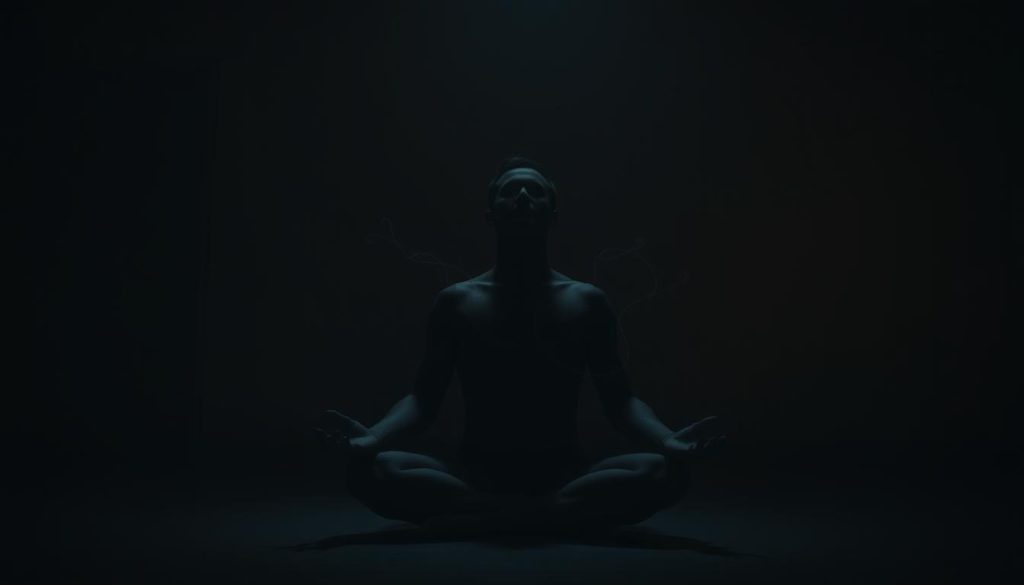Curious about hypnosis but worried you might lose control? We get it. Misconceptions make the practice sound mysterious. Trained clinicians, though, use it as a clear, intentional trance that you guide yourself into.
This gentle process supports health and focus. It helps with stress, sleep, pain, and anxiety. Many people reach for it when life feels loud.
We’ll map a simple process. Short steps. Grounded science. Playful practice. Little rituals add up over time and lead to real changes.
Expect steady results, not magic. With practice, the benefits grow. You’ll find calmer mornings, kinder inner talk, and more space between trigger and choice.
Ready to try a brief routine? We’ll move from curiosity to calm together, with tools, scripts, and a friendly compass for your inner journey.
Self-Hypnosis, Not Stage Tricks: What It Is and How It Feels
Think of trance not as stage drama but as a quiet shift in attention you can invite anytime. It’s like the moment you lose track of a movie or miss an exit on the highway. That narrowed focus is a gentle door into a supportive inner state.
Everyday absorption vs. focused attention
In this calm state, outer noise softens and inner awareness grows. Your breath slows, your eyes relax, and the mind drifts toward a single point of focus.

Guiding thoughts with clear intention
You choose a quiet place, pick a simple focal cue, then breathe—breathing slowly helps you gently close eyes. You remain in charge. Suggestions and goals work like tuning a dial: subtle shifts in thoughts and emotion over time.
People often notice warmth in the hands, a heavier body, or fewer stray thoughts. With steady practice, the doorway opens faster and the calming results feel natural, not mysterious.
The Science Behind Self-Hypnosis for Stress, Sleep, and Pain
Researchers have tracked clear brain shifts when people enter a guided suggestion state. Neuroimaging shows attention narrows, certain networks quiet, and the body cues a relaxation response. That shift is the core of the process and explains measurable effects.
The evidence is growing. A 2018 follow-up in palliative care linked hypnotic sessions with reduced pain and anxiety over two years. A 2021 randomized pilot in adults with sickle cell disease reported better self-reported pain impact and improved sleep. A 2020 trial in menopausal participants found improved sleep quality.

What this means for people: the direction is encouraging. Reviews note consistent benefits for sleep and stress during medical care, while calling for more rigorous trials. Results vary, but gains—more rest, less pain, calmer nerves—pile up over time.
Finally, hypnosis and meditation share roots but differ. Hypnosis favors imagery and direct suggestions. Meditation often centers on open awareness or breath. Both support health, and focused suggestion can also help habit shifts like weight management when paired with lifestyle changes. If you want to explore practical tools, explore our tools that complement this gentle process.
How to Use Self-Hypnosis for Stress Relief in Daily Life
Begin by naming one clear goal and choosing a cozy place. A soft chair, low light, and no interruption tell your nervous system it’s safe. Keep the aim small and specific so the mind can follow.
Set your goal and prepare your space
We pick one intention, settle into a comfortable place, and set a soft timer if helpful. This simple ritual frames each session and makes practice easier over time.
Induction steps
Soften your gaze on a point, then breathe—breathing slowly—until eyelids feel heavy. Let the eyes close naturally and follow a calm rhythm of breath.
Deepen relaxation
Scan the body from toes to head, releasing each muscle group. Invite a sense of heaviness and notice tension unspool like thread.
Visualization and suggestions
Build a simple scene—a beach or forest—then layer senses: color, sound, temperature. Use present-tense suggestions tied to your goal. Keep phrases believable and steady.
Return with intention
After about five minutes, count up, deepen a breath, and wiggle fingers and toes. Reorient gently. For sleep, stay in bed and let the countdown drift into dreams.
Practice two or three short sessions a week and your method will refine itself. Small, steady steps create lasting change.

Methods, Scripts, and Guided Self-Hypnosis You Can Use Today
Small, clear methods make it easy to find calm between tasks. We offer a tight four-step process that fits a coffee break or a commute pause. Keep your aim simple and pick one goal per session.
Short-form four-step method for busy days
1. Set the mood: quiet spot, low light, optional music.
2. Relax the body: deep breaths and progressive release.
3. Plant positive suggestions: brief, sensory, present tense.
4. Visualize the outcome: see the goal and feel it as real.
Choosing affirmations: “you” vs. “I” language
Try both. Many practitioners find you phrasing reaches the subconscious faster — for example, “You feel calm now.” Other people prefer I statements like “I am calm.” Test which phrasing lands deeper for you and keep suggestions single-minded and believable.
Audio and app-based sessions
Audio sessions can speed learning. Guided tracks give pacing, tone, and imagery so you can simply follow along. Look for short formats—5 and 12 minutes—that match your schedule. Structured programs can boost consistency and make the practice stick.
Practical Tips to Get Better Results and Track Your Progress
Short rituals anchor calm and make results easier to notice over weeks. We favor tiny, repeatable moves that fit real days. This is a trainable skill; gentle repetition deepens ease and focus.
Practice frequency, best times, and session length
Try two short sessions on weekdays and one longer session on the weekend. Keep weekday sessions to 5–10 minutes and the weekend session 15–20 minutes. Consistency beats marathon efforts.
Linking sessions to triggers and breath cues
Anchor sessions to daily moments—morning stretch, lunch pause, bedtime. Teach a micro-trigger: one slow breath, a single cue word, and a 20-second inner reset. Use that cue anywhere, any place.
Journaling goals, sessions, and effects
Keep a tiny log: date, goal, scene, feelings before and after. This simple habit makes subtle changes visible and shapes behaviors into lasting habits.
Extra notes: Distraction or sleepiness is normal. Treat it as data, not failure. For health goals like weight loss, pair brief sessions with small habits—drink water before snacks or pause a mindful minute before meals.
Safety, Limits, and When to Work with a Hypnotherapist
We want your curiosity to be brave and safe, so here are clear cautions and sensible next steps. Short practices help many people, but certain health signals deserve professional attention.
Who should seek medical advice before trying
Red flags: If you live with schizophrenia, dissociative disorders, a history of seizures, or recent major trauma, consult a clinician first.
If you face extreme emotional distress, PTSD, or ongoing mental health crises, reach out for medical care before practicing. These conditions can complicate suggestion work and may need tailored support.
What a hypnotherapist adds and how professional sessions differ
A hypnotherapist begins with a careful intake. They assess health, worry about triggers, and craft targeted scripts that fit your goals.
In a session, the guide manages induction, watches for rising anxiety, and adapts imagery to ease pain or improve sleep. This focused work often speeds progress and deepens effects compared with solo practice.
Remember: hypnosis complements medical and psychological care, not replace it. If your progress stalls, emotions overwhelm you, or sleep and pain patterns stay complex, consider a consult. Try a few self-led sessions, then invite a hypnotherapist as a supportive ally when you want deeper, safer change.
Make Relaxation a Habit: Bring Self-Hypnosis Into Everyday Life
Invite a quick visualization whenever time slips between tasks, and the hypnotic state returns faster. Small rituals travel with you across work, workouts, and evenings, shaping calmer behaviors and subtle changes in mood.
We blend meditation and imagery so a short cue can shift awareness. Try half-minute scenes before calls, a brief breath before meals, and gentle sessions that support sleep, ease anxiety, and reduce pain.
Our promise: tiny practices, many days, real benefits. If you want guided tracks or directories for extras, reputable resources are available and offer practicing self-hypnosis help when people need extra support.
